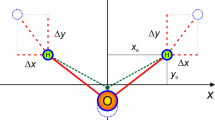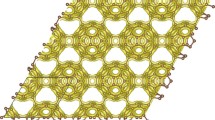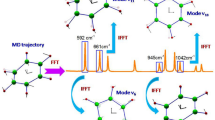Abstract
THE band systems of C2H2 and C2D2 at 2400–2100 A. have been studied in absorption, and the vibrational and resolved rotational structures fully analysed. It emerges that, in its excited state, acetylene is a plane centrosymmetric zig-zag (like ethylene from which two trans-related hydrogen atoms have been removed). It is therefore an asymmetric top. Its dimensions in the lowest vibrational level of that state are CC = 1.383 A., CH = 1.08 A., ∠CCH = 120.2°. The frequency of the CC stretching vibration is 1,385 cm.−1 in C2H2 and 1,300 cm.−1 in C2D2, the derived mean force-constant being F = 7.2 × 105 dyne/cm.; while the vibration which together opens the angles has the frequency 1,049 cm.−1 in C2H2 and 835 cm.−1 in C2D2, the corresponding mean bending-force-constant being δ = 8.5 × 10−12 dyne.-cm./radian. The electronic wave function has the two-fold axis and plane, but not the centre of symmetry of the zig-zag molecule. The lowest vibrational level of this bent excited state lies at 42,209 cm.−1 in C2H2 and at 42,280 cm.−1 in C2D2, above that of the linear normal state, the difference of 71 cm.−1 arising from differences in zero-point vibrational energy. In the transition from the normal to the excited state, the electrons oscillate perpendicularly to the plane of the bent molecule. The resultant electron-spin remains zero. The transition probability, expressed as an oscillator strength, is 8 × 10−5. All this follows from the analysis of the spectra.
This is a preview of subscription content, access via your institution
Access options
Subscribe to this journal
Receive 51 print issues and online access
$199.00 per year
only $3.90 per issue
Buy this article
- Purchase on Springer Link
- Instant access to full article PDF
Prices may be subject to local taxes which are calculated during checkout
Similar content being viewed by others
References
Garforth, Ingold and Poole, J. Chem. Soc., 508 (1948).
Cf. Mulliken, Phys. Rev., 60, 506 (1941).
Author information
Authors and Affiliations
Rights and permissions
About this article
Cite this article
KING, G., INGOLD, C. The Bent Excited State of Acetylene. Nature 169, 1101–1102 (1952). https://doi.org/10.1038/1691101b0
Issue Date:
DOI: https://doi.org/10.1038/1691101b0
Comments
By submitting a comment you agree to abide by our Terms and Community Guidelines. If you find something abusive or that does not comply with our terms or guidelines please flag it as inappropriate.



